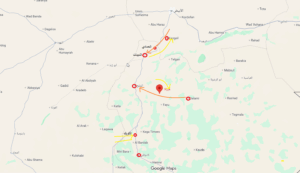‘New SDG 1,000 note proves Sudan Pound’s plunging purchasing power’
The announcement by the Central Bank of Sudan on Monday that it will issue a new banknote of SDG 1,000 reflects the rising inflation in the country and the continued erosion of the purchasing power of the Sudanese pound, despite a relatively stable exchange rate.
 Sudanese banknotes (Photo: RD)
Sudanese banknotes (Photo: RD)
The announcement by the Central Bank of Sudan on Monday that it will issue a new banknote of SDG 1,000 reflects the rising inflation in the country and the continued erosion of the purchasing power of the Sudanese pound, despite a relatively stable exchange rate.
In an interview with Radio Dabanga’s Sudan Today programme, economic and political analyst Hafiz Ismail said that the issuing of the SDG 1,000 denomination is a sign of rising inflation and the continued erosion of the purchasing power of the Sudanese pound, in spite of the fact that the exchange rate of the Sudanese Pound against international currencies is relatively stable at the moment. The SDG 1.000 note is the newest addition in a series of new notes of increasingly higher values issued over the last few years.
Ismail says that the marked increase in taxes and customs duties will also have significant inflationary effects, and attributes the significant rise in inflation to the state of depression in the country. This is exacerbated by the fact that the large commercial banks must service extensive debts to the Bank of Sudan, so that they are hesitant to lend money to their clients.
He attributes the relative current stability of the Pound rate to the recession and the cessation of commercial movement, and unaffordable process for consumer basics in the country. “The public have even abandoned necessities due to the lack of purchasing power. This recession negatively affects production, which leads to disastrous results.”
Hyperinflation
In 2019, banks across the country limited cash withdrawals, which intensified in the run-up to the overthrow in the Al Bashir regime in April 2019. This resulted in long queues of customers trying to withdraw a little cash from the banks. Public trust in the banking system dwindled, so traders and the public took to keeping their money at home, rather than deposit it into banks.
The socioeconomic detritus of the 30-year dictatorship of Al Bashir, who has also been on trial in Khartoum for currency offences, has left Sudan’s economy in ruins, with the value of the Sudanese Pound (SDG) at all-time lows against international currencies.
In its dying throes, the Al Bashir regime desperately ordered the printing of new currency denominations of SDG 100, SDG 200, and SDG 500 by the Central Bank of Sudan in an attempt to solve the chronic public and commercial liquidity crisis.
In the years after, concerns about the rising inflation grew, strengthened by Sudan’s importing of most basic needs, the budget deficit, and the dramatic increase in salaries financed through the printing of banknotes, which led to a further devaluation of the Pound.
In attempts to revitalise the currency, in February 2020, the government unified the Sudanese Pound exchange rate in an attempt to halt the ongoing inflation. At that time, the official exchange rate for 1USD was adjusted from SDG55 to the prevailing parallel market rate of SDG375.
Most recently in March this year, the Central Bank of Sudan stopped issuing the indicative price, after it again announced the unification of the Sudanese Pound exchange rate to allow for the determination of currency exchange rates without interference from the Central Bank. Foreign exchange dealers on the parallel market reported that the Dollar exchange rate at the time was SDG560.
United Nations reports indicate that the value of the local currency has decreased 20 times (2,000 per cent) during the past five years.











 and then
and then